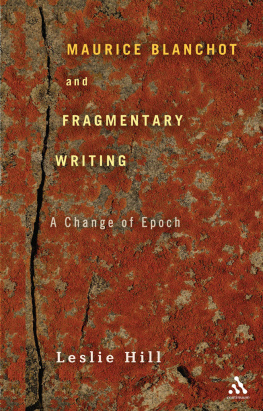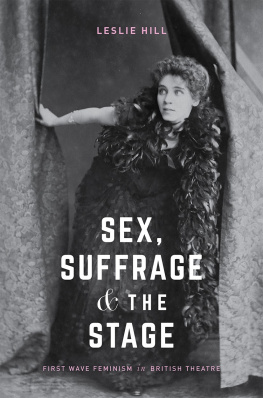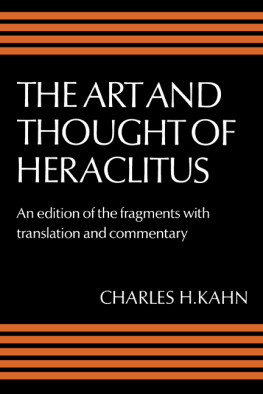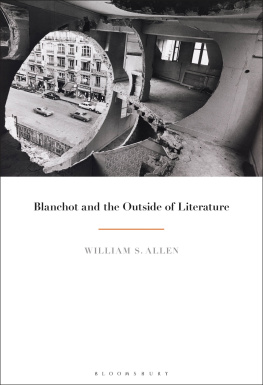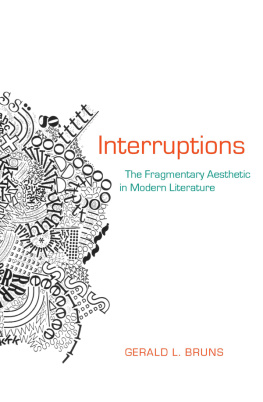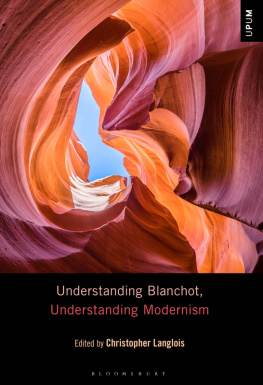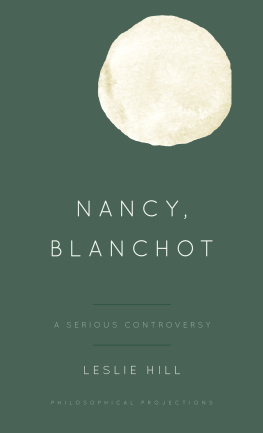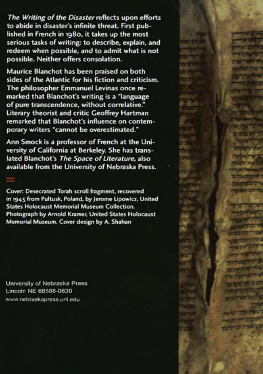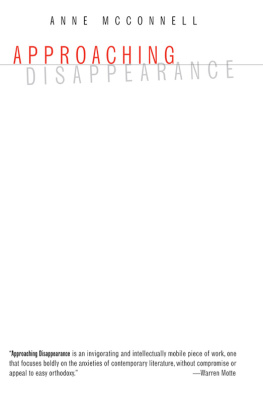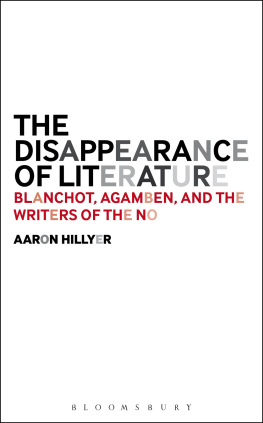Maurice
Blanchot and
Fragmentary
Writing

Continuum International Publishing Group
A Bloomsbury company
50 Bedford Square 80 Maiden Lane
London New York
WC1B 3DP NY 10038
www.continuumbooks.com
Leslie Hill 2012
Extracts from Awaiting Oblivion reprinted from Awaiting Oblivion by Maurice Blanchot, translated by John Gregg, by permission of the University of Nebraska Press. Copyright 1962 by Editions Gallimard. Translation copyright 1997 by the University of Nebraska Press.
Extracts from The Infinite Conversation reprinted by permission from The Infinite Conversation by Maurice Blanchot, translated by Susan Hanson, The University of Minnesota Press, 1993. English translation copyright 1993 by the Regents of the University of Minnesota. Originally published as LEntretien infini, copyright 1969 by Editions Gallimard.
Extracts from The Step Not Beyond reprinted by permission from The Step Not Beyond by Maurice Blanchot, translated by Lycette Nelson, The State University of New York Press 1992, State University of New York. All rights reserved.
Extracts from The Writing of the Disaster reprinted from The Writing of the Disaster by Maurice Blanchot, translated by Ann Smock, by permission of the University of Nebraska Press. Copyright 1980 by Editions Gallimard. Translation copyright 1986, 1995 by the University of Nebraska Press.
All rights reserved. No part of this book may be reproduced, stored in a retrieval system, or transmitted, in any form or by any means, electronic, mechanical, photocopying, recording, or otherwise, without the permission of the publishers.
Library of Congress Cataloging-in-Publication Data
Hill, Leslie, 1949
Maurice Blanchot and fragmentary writing: a change of epoch/by Leslie Hill.
p. cm.
Includes bibliographical references and index.
ISBN-13: 978-1-4411-2527-9 (hardcover: alk. paper)
ISBN-10: 1-4411-2527-2 (hardcover: alk. paper)
ISBN-13: 978-1-4411-6622-7 (pbk.: alk. paper)
ISBN-10: 1-4411-6622-X (pbk.: alk. paper)
eISBN: 978-1-4411-7127-6
1. Blanchot, Maurice--Criticism and interpretation. I. Title.
PQ2603.L3343Z684 2012
843.912--dc23
2012002893
ISBN: HB: 978-1-4411-2527-9
PB: 978-1-4411-6622-7
CONTENTS
I should like to thank the many friends, colleagues, and students who, sometimes without realising, have contributed to the writing of this book. I am particularly indebted to Andrew Benjamin, Christophe Bident, Christopher Fynsk, Sen Hand, Kevin Hart, and Joseph Kuzma for their encouragement, support, and insight, and am grateful to the University of Warwick for the provision of study leave that enabled me to complete what became a significantly longer book than first envisaged.
Earlier versions of portions of this book have appeared elsewhere and I am grateful for permission to use some of that material again. Parts of Chapter One and Chapter Two were first published as A Fragmentary Demand in The Power of Contestation: Perspectives on Maurice Blanchot, edited by Kevin Hart and Geoffrey H. Hartman (Baltimore: Johns Hopkins University Press, 2004), 101120, 205209 2004 The Johns Hopkins University Press; adapted with permission of The Johns Hopkins University Press. Some further remarks from Chapter One were borrowed for inclusion in an article in a Blanchot special issue of the journal Europe (August-September 2007) and an initial draft of the opening section of Chapter Three likewise first appeared in French in Maurice Blanchot, la singularit dune criture, edited by Arthur Cools, Nausicaa Dewez, Christophe Halsberghe, and Michel Lisse (Les Lettres romanes, hors srie, 2005). A preliminary sketch of the first section of Chapter Four was published in Blanchot dans son sicle, edited by Monique Antelme and others (Lyon: ditions Parangon, 2009). All these texts have been substantially revised for the present book.
I
A spectre
All becomes suspense, a fragmentary arrangement of alternating and facing elements, contributing to the total rhythm, which may be deemed the silent poem, with its blanks; translated only, in singular manner, by each pendentive [ Tout devient suspens, disposition fragmentaire avec alternance et vis--vis, concourant au rythme total, lequel serait le pome tu, aux blancs; seulement traduit, en une manire, par chaque pendentif].
MALLARM,Crise de vers
For more than two hundred years, testifying at once to the weighty legacy of the past and the uncertain prospect of the future, a spectre has haunted literature. Its name is legion, its signature nevertheless unmistakeable: it is the spectre of fragmentary writing, of the text as fragment and the fragment as text. Time and again, whenever a fresh break in continuity is diagnosed or a new episode in cultural history declared, under such grandly vacuous names as Romanticism, Modernism, Postmodernism, even Postpostmodernism, it is repeatedly to the literary fragment that critics have turned in search of an emblem of the seemingly unquenchable desire to make it new. Since the early nineteenth century, the list of literatures fragmentary artists is at any event a long one: Schlegel, Hlderlin, Keats, Novalis, Coleridge, Bchner, Nietzsche, Mallarm, Pound, Eliot, Kafka, Valry, Proust, Musil, Artaud, Char, Bataille, Beckett, numerous others too, in whose work the fragment, whether calculated as such or merely abandoned to its fate, bears witness to the trials and tribulations, birthpangs as well as death-throes, of literary, historical, and cultural upheaval.
The time of the fragment, in other words, is never the fullness of the present. It is the time of between-times: between remembering and forgetting, continuity and discontinuity, obedience and objection; and what speaks most powerfully in the fragment is no doubt precisely this unreconciled tension between the artwork and its unravelling, between its gathering and its dispersion, between time past and time still to come. In that tension lies redoubtable energy, and this explains why, in critical discourse and artistic practice alike, the fragment today is little short of ubiquitous. Little has escaped its appeal: not fiction, not poetry, nor theatre; not autobiography, not memoir, nor essay; not philosophy, not theory, nor criticism. Notwithstanding its unassuming discretion, despite the intimations of apocalypse that sometimes follow in its wake, fragmentation seems now to have become almost synonymous with the possibility of writing itself. But the phenomenon is not limited to the printed word. Much the same goes for other artforms, too: for painting, music, sculpture, dance, film, photography, and the many other multimedia activities that, taking their lead from the fragment, tenaciously defy categorisation.
And yet there is something deeply ambiguous about this fidelity to the fragment that is such a remarkable feature of modern and contemporary experience. It is that even by its most enthusiastic exponents the fragment is rarely considered to evoke anything other than negativity. Whether seen to force itself on its audience with fractious, transgressive violence, or to withdraw into the melancholy disenchantment that comes from shattered dreams, the fragment is customarily described by critics not according to what it is or to what it might be, but to what it already is not: in terms, that is, of the continuity it interrupts, the unity it breaks apart, the authority it contests, the norms it breaches. Reasons for this strange state of affairs are admittedly not hard to find. They follow in part from the concept of the fragment itself. As Adorno argues in his posthumous (and itself fragmentary)

